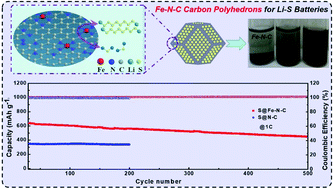Effectively confining lithium polysulfides (LiPSs) and efficiently catalyzing their conversion represent a judicious approach to the preparation of high-rate, long lifespan lithium–sulfur (Li–S) batteries. Herein, an Fe-containing zeolitic imidazolate framework Fe-ZIF-8 is used as a precursor to synthesize a Fe–N–C polyhedron composite that shows a high specific surface area of 1459.3 m2 g−1, a large pore volume of 1.037 cm3 g−1 and a high nitrogen content of 7.29 at%. Benefiting from the high surface area and polarity of the carbon matrix, the Fe–N–C polyhedron composite can effectively adsorb and confine LiPSs. The S@Fe–N–C based electrode with a high sulfur loading of 72 wt% shows a high initial specific capacity of 1296 mA h g−1 at 0.1C and can retain a capacity of 450 mA h g−1 after 500 charge–discharge cycles at 1C, corresponding to a low fading rate of 0.068% per cycle. In contrast, a low capacity of 345 mA h g−1 is observed for the S@N–C reference electrode even after only 200 cycles. Moreover, the Fe–Nx–Cy sites within the S@Fe–N–C electrode can also efficiently catalyze the redox conversion of LiPSs during the charge–discharge process, leading to a much higher reversible capacity of 1178 mA h g−1 at 0.1C, as compared with the 626 mA h g−1 for the S@N–C electrode. These results support the approach to the preparation of N-doped porous carbons with catalytically active M–Nx–Cy (M is transition metal) sites for high-rate, long-lifespan sulfur cathodes for Li–S batteries.

